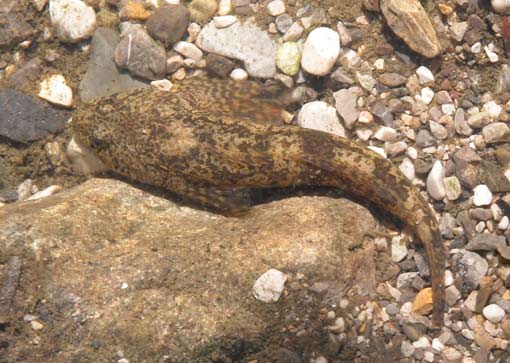Progetto Life - Provincia di Prato
Cottus gobio Linnaeus, 1758
- Common name: EUROPEAN BULLHEAD
- Phylum : FISH;
- Class: OSTEICHTHYES;
- Order: SCORPENIFORMES;
- Family: Cottidae;
Description and distinctive features:
Cottids, which are only found in the northern hemisphere with a circumpolar distribution area, are usually benthic animals with a fusiform body and a big head, often compressed in the dorsoventral direction. The eyes are positioned on the top of the head and very close together, with a wide mouth. The skin is almost completely devoid of scales, but there are barbs or tubercles on the body, concentrated particularly on the head. They have two dorsal fins and the pectoral fins are usually large and fan-shaped. A lateral line runs along the sides, which are typically a sense organ for fish formed of a channel running along the animal's sides, which in this family is often incomplete or interrupted in several points. The swim bladder is absent (Tortonese, 1975). One of the most recent and systematic revisions of the data available on this group was conducted by Yabe (1985), based on osteological features. Of the over 1200 species of Scorpaeniformes, only just over 50 live in fresh water and the vast majority of these are Cottids (although this family does include a large number of marine species, Nelson, 1994). The European bullhead is a small sized species, measuring no more than 15 cm in length (Gandolfi et al., 1991). It has a rather wide mouth and prominent cheeks. Its colour varies from brown to greenish with darker makes spread over the entire surface of the body. This species has only some barbs near the pectoral fins. If carrying out a superficial examination, the European bullhead may be confused with the Goby, given the general similarity between the two species, but the different shape of the ventral fins (which are divided in the European bullhead) and the total lack of scales, in addition to its size slightly larger size, make this species unmistakable when closer examination is performed.
Ecological notes:
Sexual maturity is reached after 2 years. Few individuals survive more than 4 years in lowland waters, while they can live as long as 8-9 years in mountain waters where they grow more slowly (Gandolfi et al., 1991). The species prefers high altitude streams and lakes throughout the Alpine area and part of the Apennines, where it lives on stony beds and moves mainly at night. It can also be found in lowland spring waters. In the Baltic area, it has also been found in salt water (Miller and Loates, 1997). The species is territorial and can be found during the day hiding among the stones or aquatic plants. It swims rather slowly, moving in short bursts from one stone to another. Its diet is composed of small aquatic invertebrates, although some episodes of cannibalism have been observed during the breeding period, involving both eggs and young (Marconato and Bisazza, 1988).
Distribution:
Distributed throughout Europe, except for Scotland, Ireland and Spain (Tortonese, 1975; Miller and Loates, 1997). In Italy, despite its fragmentary distribution, the European bullhead is present throughout the Alpine area and Apennine water courses, both on the Tyrrhenian and Adriatic sides. In this respect, we note that the species is considered native to both the most important fish districts in Italy. This is actually an approximation because there is currently insufficient data with which to attribute the certain autochthony of the species to one of the two areas. Scientific research based on molecular analysis is currently under way with the aim of clarifying the geographic origin of the species and its distribution.
Distribution in the Province of Prato:
The European Bullhead has been captured in both the sub-basin of the Limentra Torrent and in the Setta Torrent, which are both part of the Reno River basin (Adriatic side of the Province of Prato), as well as in the sub-basin of the Bisenzio Torrent, belonging to the basin of the Arno river (Tyrrhenian side). The survey stations where specimens of this species were found were located between 430 and 764 metres above sea level. Between 430 and 525 metres above sea level, the European bullhead was only found together with the Vairone (Telestes muticellus). In the Province of Prato, the species is known as "Brocciolo".
Status and Conservation:
The European bullhead is associated with aquatic habitats that are particularly well-preserved from the point of view of their physical-chemical features and the conditions of the water beds. Environmental degradation and the resulting changes have therefore considerably reduced the distribution and size of populations of this species. The European bullhead is also linked to water courses of a size and type that are generally used by public authorities for seeding Salmonids: this is a problem for the conservation of the species, given that Salmonids prey on young Bullheads and enter into competition with the adults for food and space. However, it has been proved that adult Bullheads are capable of placing strong predatory pressure on Brown trout fry, at least for a few days after these have finished reabsorbing their amniotic sac (Gaudin and Caillere, 2000).
Photos:

centralino: 0574 5341 | info@provincia.prato.it | credits | note legali

